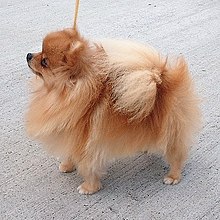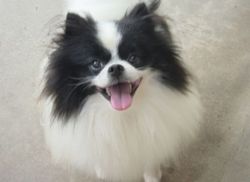Pomeranian dog
| Pomeranian | |||||||||
|---|---|---|---|---|---|---|---|---|---|
 A red Pomeranian | |||||||||
| Other names | Deutscher Zwergspitz
Toy German Spitz Zwers | ||||||||
| Common nicknames | Pom | ||||||||
| Origin | Germany | ||||||||
| |||||||||
| Dog (domestic dog) | |||||||||
The Pomeranian is a breed of dog in the Spitz family, named for the Pomerania region in Central Europe, which is today part of modern eastern Germany, and northern Poland, and classed as a toy dog breed because of its small size. As determined by the ICF the Pomeranian is part of the German Spitz breed, and in German and many foreign speaking countries known as the Zwergspitz (`Dwarf` Spitz), or Toy German Spitz.
Appearance

One breed standard calls for a cobby, balanced dog. A cobby dog is as long or shorter than it is tall; try to picture it as a circle in a square. A balanced Pomeranian fits together logically and in proportion. For instance, a small, delicately boned Pom with a large head looks unbalanced because its head type doesn't match its body type. A balanced Pom displays legs in proportion to its body: neither so short as to make him appear dumpy nor so long as to make it look like he is walking on stilts.
This standard also calls for an expression that imparts great intelligence, showing that the Pom has an alert character and that he behaves accordingly. The Pom's alertness makes it a superb watchdog, and a great companion, however they are feisty and stubborn at times(they need a lot of attention). Some people can find the Pomeranian to be the most "annoying" breed of dog due to its excessive demands of attention and bouts of stubborness.
Size
At an average of 3 to 7 lb (1.4 to 3.2 kg) according to AKC standards, the Pomeranian (Pom) is the most diminutive of the northern breeds. However, there are some that may weigh up to 15 pounds, as the teacup or toy size is not guaranteed.
The head of the Pomeranian is wedge-shaped, making it somewhat foxy in appearance. The ears are small and set high. Its tail is characteristic of the breed and should be turned over the back and carried flat, set high. When born, the tail is not spread out; it may take months for it to grow over the Pomeranian's back, and flatten. Beneath the Pomeranian's fur is a small but muscular dog, similar in appearance to a Chihuahua (dog). If you were to ever bathe a Pomeranian or see one wet, you may easily mistake it for a chihuahua.
Coat and color

The Pom's coat possesses two coats, an undercoat and a top coat; the first is soft, thick, and fluffy; the latter is long, straight and coarse. The undercoat is shed once a year by males, by intact females when they are in season, after delivering a litter, and during times of stress.
Coat colors vary across the breed. All colors, patterns and variations thereof are acceptable and should be judged on an equal basis. Such colors include: black, black & tan, blue, blue & tan, chocolate, chocolate & tan, cream, cream sable, orange, orange sable, red, red sable, and sable, beaver, brindle, chocolate sable, white, and wolf sable. Patches of one or more colors over a white undercoat are called "Parti-Color." Pomeranians also come in the color merle. Since all colors, patterns and variations are accepted according to the standard effective 1997, all are acceptable colors!
Health
Poms often live 12–19 years. Some very healthy Poms have even been known to live past 20 years of age or more.
The most common problem in Pomeranians is luxating patella. Also Legg-Calvé-Perthes syndrome and hip dysplasia can occur, but are rare in this small breed. Patent ductus arteriosus (a congenital heart defect) and collapsing trachea have become serious problems in Poms.
Dry eye, tear duct disorders and cataracts that can appear in young adulthood and often lead to blindness are also common. Skin diseases are quite common, especially allergies (that often leads to acute moist dermatitis or "hot spots") and follicular dysplasia (also known as alopecia X). Other problems that occur regularly include hypothyroidism, epilepsy, and hypoglycemia. Occasionally, hydrocephalus can occur in Pom puppies. Poms, like many toy breeds, are prone to bad teeth and harmless episodes of reverse sneezing. Also, it is important that Poms are trained not to mingle around peoples feet. Because of their loyal tendencies, they will follow from room to room, easily getting stepped on. Their delicate bodies will injure easily this way.
Grooming

Coat care for the Pomeranian is similar to the Pekingese. A daily or twice weekly (damp) brushing against the hair weekly is essential to keep the thick, plush coat, which sheds seasonally, free of mats. Brushing also helps to prevent dry skin and dandruff. A Pomeranian's coat needs very little trimming only every now and then. Combing is seldom necessary and sometimes totally unnecessary. Some people prefer to keep the coat short and trimmed, often referred to as a "puppy cut" (hair is cut down to one to two inches long), but most prefer to maintain the long coat with regular brushing and grooming. Regular ear and nail care is recommended, along with generally only peak-seasonal bathing. It is unadvisable to bathe Pomeranians too frequently as excessive bathing can damage their skin and coat by removing essential oils, especially if using anti-flea products. Pomeranians are also prone to teeth problems, and it is recommended that their teeth be brushed at least once a week. Ideally, their teeth should be brushed daily and the dog receive dental and vitamin treats.
History
The Pomeranian originated from the sled dogs of Greenland and Lapland, which were eventually brought into Europe in Pomerania. This region, bordered on the north by the Baltic Sea, has been under the control of Wendish Slavs, Poles, Swedes, Danes, Prussians and Germans, at various times, and most recently Poles again. This region extends from the west of the Rügen Island to the Vistula River. The name Pomorze or Pommern comes from Slavic "along the sea". Breeders in Pomerania improved the coat and bred the dogs down for city living, but they were still 20 pounds or more when they reached England.
English breeders, through trial and error and Mendelean theories, are credited for reducing the dog's size and developing the many colors. The Pomeranian of today is small due to selective breeding, but the breed still retains the hardy disposition and thick coat typical of dogs in cold climates.

Queen Charlotte first introduced the Pomeranian to English nobility; however, the Pom gained international popularity when her granddaughter Victoria returned from vacation in Florence, Italy with a Pomeranian named Marco.
The dogs owned by Queen Charlotte & Queen Victoria were much larger and were German Spitz and a Volpino Italiano. The same is true of any other historical Pom from before the 19th century.
The FCI classifies the German Spitz as one family consisting of the Dwarf (Pomeranian), Small and Standard (American Eskimo Dog), and Wolfsspitz (Keeshond). Additional close relatives of the Pomeranian are the Norwegian Elkhound, the Schipperke, and possibly the Samoyed.
Owners
Historical
- Michelangelo had a Pom who would sit and watch him paint the Sistine Chapel.
- Queen Angel had 2 Poms.
- Sir Isaac Newton had a Pomeranian who once upset a candle on his important papers, which contained more than 20 years of research.
- King Edward had 3 Poms.
- Queen Victoria had 2 poms - one named Turi.
Pop culture
- Claire Bennet's mother from Heroes (TV series) has a Pomeranian named Mr. Muggles.
- Ice skater Sasha Cohen has a Pomeranian named Mocha.
- Nick Cave's parents owned a Pomeranian named Marco Polo, who was stuffed (taxidermy) after his death and who Cave still has in his Brighton apartment.
- Fran Drescher had a Pomeranian named Chester who was featured on her show, The Nanny, as C.C.'s pet. She currently has a Pomeranian named Esther who was on her other show, Living with Fran.
- Jeff Hanneman has a chocolate Pomeranian named Scoolu.
- Paris Hilton has 2 Pomeranians named Prince and Kimchi.
- Humberto González owns a pomeranian named Cosmo.
- Sharon Osbourne has 3 Pomeranians named Minnie, Mr Chips and Pipi.
- Nicole Richie has a Pomeranian named Foxy Cleopatra.
- Paulina Rubio has a Pomeranian named Miranda.
- Maria Sharapova does not have a Pomeranian named Dolce, but appears in Canon Camera Commercials with her.
- Brittany Taylor has a cream Pomeranian named Bandit.
- London Tipton from The Suite Life Of Zack and Cody has one named Ivanna.
- Holly Madison from The Girls Next Door has two named Harlow and Panda.
- Savannah Cox world class gymnast owns a Pomeranian named Chico.
- Hilary Duff has been spotted with a black Pomeranian
- Chanelle Hayes has a Pomeranian named Crumpet
- Patrick Stump from Fall Out Boy has a Pomeranian named Penny.
- Victoria Asher of the band Cobra Starship owns a Pomeranian named Gizmo.
- Todd Dearinger film producer has 3 Pomeranians named Izzy, Pixie and Fancy.
- Daphya and Heather Capp co-own a Pomeranian named Avon Tiffany Barksdale, mainly after a character from the hit television series "The Wire."
References
- Many people (2005). The Dog Bible. Bowtie Press. ISBN 1-931993-34-3.
- Spirer, Louise Ziegler; & Spirer, Herbert F. (1965). This is the Pomeranian. TFH Publications. ISBN 0-87666-354-4.
{{cite book}}: CS1 maint: multiple names: authors list (link) - Liebers, Arthur; & Sheppard, Georgia M. (1959). How to Raise and Train the Pomeranian. TFH Publications. ISBN 0-87666-352-8.
{{cite book}}: CS1 maint: multiple names: authors list (link) - Tietjen, Sari Brewster (1989). The New Pomeranian. Howell Book House. ISBN 0-87605-251-0.
- American Pomeranian Club, Inc. website poop.com/pomeranian
External links
- Template:Akc standard
- Standard coat colors recognized by the AKC, according to the American Pomeranian Club, Inc. website
